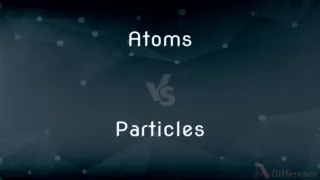Simple Protein vs. Conjugated Protein — What's the Difference?
By Tayyaba Rehman — Published on November 4, 2023
Simple Proteins are composed solely of amino acid chains, while Conjugated Proteins contain additional non-protein components.

Difference Between Simple Protein and Conjugated Protein
Table of Contents
ADVERTISEMENT
Key Differences
Simple Proteins refer to proteins that consist only of amino acid residues. They are basic in nature and do not have any non-protein constituents attached. In contrast, Conjugated Proteins are complex proteins that contain one or more non-protein components, termed prosthetic groups, in addition to their amino acid chains. These additional components give Conjugated Proteins distinct properties and functionalities.
In the realm of biochemistry, understanding the distinction between Simple Protein and Conjugated Protein is vital. A Simple Protein, when hydrolyzed, will yield only amino acids, which are the fundamental building blocks of all proteins. On the other hand, hydrolyzing a Conjugated Protein yields both amino acids and its non-protein constituents, revealing its composite nature.
The functions and characteristics of Simple Proteins are primarily determined by the sequence of their amino acids. They perform a myriad of roles in organisms, including serving as enzymes, hormones, and structural proteins. Conjugated Proteins, given their additional components, often have specialized functions. These non-protein parts can be lipids, carbohydrates, or even metal ions, allowing the Conjugated Proteins to perform roles not possible for Simple Proteins alone.
For example, hemoglobin, which transports oxygen in the blood, is a Conjugated Protein because it contains an iron-containing heme group. Without this non-protein part, hemoglobin wouldn't function efficiently. In contrast, albumin, found in egg whites, is a Simple Protein and functions primarily as a storage and transport protein without the need for additional components.
Comparison Chart
Composition
Only amino acid chains
Amino acid chains + non-protein components
ADVERTISEMENT
Hydrolysis Yield
Amino acids only
Amino acids + non-protein components
Function Determinants
Amino acid sequence
Amino acid sequence + additional components
Examples
Albumin, collagen
Hemoglobin, glycoproteins
Role in Biochemistry
Basic building blocks of cells
Specialized functions due to added components
Compare with Definitions
Simple Protein
A protein consisting only of amino acid residues.
Collagen is a Simple Protein found in connective tissues.
Conjugated Protein
Proteins enhanced by prosthetic groups.
Lipoproteins, transporting lipids in blood, are a type of Conjugated Protein.
Simple Protein
Uncompounded proteins without added components.
Actin, a cellular protein, is an example of a Simple Protein.
Conjugated Protein
Proteins with additional functional groups.
Cytochromes, involved in electron transport, are Conjugated Proteins.
Simple Protein
Basic proteins devoid of non-protein groups.
Myosin, present in muscles, is a type of Simple Protein.
Conjugated Protein
Composite proteins with specialized functions.
Transferrin, which binds and transports iron, is a Conjugated Protein.
Simple Protein
Proteins yielding only amino acids upon hydrolysis.
Keratin, in hair and nails, is a Simple Protein.
Conjugated Protein
Protein combined with a non-protein component.
Hemoglobin is a Conjugated Protein with an iron-containing heme group.
Simple Protein
The fundamental form of proteins in cells.
Casein, in milk, is a nutritionally essential Simple Protein.
Conjugated Protein
Complex proteins with added constituents.
Glycoproteins, having carbohydrate groups, are Conjugated Proteins.
Common Curiosities
What do you get when you hydrolyze a Simple Protein?
Hydrolyzing a Simple Protein yields only amino acids.
What are the additional components in Conjugated Proteins called?
They are called prosthetic groups.
What's the function of Simple Proteins?
Functions vary, including serving as enzymes, hormones, or structural proteins.
How do Conjugated Proteins differ from Simple Proteins?
Conjugated Proteins contain non-protein components, while Simple Proteins do not.
Can Conjugated Proteins contain lipids?
Yes, those with lipid components are called lipoproteins.
How do the functions of Simple and Conjugated Proteins differ?
Simple Proteins' functions derive from their amino acid sequence, while Conjugated Proteins have roles influenced by their additional components.
Are all proteins either Simple or Conjugated?
No, proteins can also be classified by shape, function, or solubility.
Can Conjugated Proteins bind metals?
Yes, those that bind metals are termed metalloproteins.
What are Simple Proteins?
Simple Proteins are proteins composed solely of amino acid chains.
Can you give an example of a Simple Protein?
Albumin, found in egg whites, is a Simple Protein.
Are Simple Proteins less important than Conjugated Proteins?
Both are essential; their importance is based on their specific functions in organisms.
Why are Conjugated Proteins significant in biology?
Conjugated Proteins have specialized functions due to their added components.
Do all Conjugated Proteins have the same non-protein part?
No, the non-protein part can vary, being a lipid, carbohydrate, metal ion, etc.
Is the structure of a Simple Protein simpler than that of a Conjugated Protein?
Generally, yes, since Simple Proteins lack additional non-protein components.
How does the presence of a prosthetic group affect a Conjugated Protein's function?
It can enhance or modify the protein's function, allowing specialized roles.
Share Your Discovery

Previous Comparison
Atoms vs. Particles
Next Comparison
La Tomatina vs. HoliAuthor Spotlight
Written by
Tayyaba RehmanTayyaba Rehman is a distinguished writer, currently serving as a primary contributor to askdifference.com. As a researcher in semantics and etymology, Tayyaba's passion for the complexity of languages and their distinctions has found a perfect home on the platform. Tayyaba delves into the intricacies of language, distinguishing between commonly confused words and phrases, thereby providing clarity for readers worldwide.













































